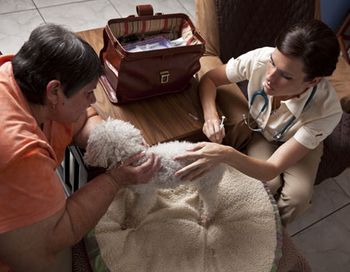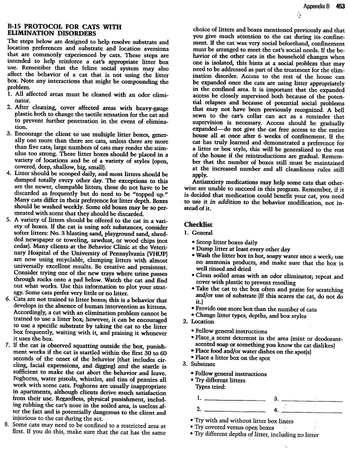
Do your clients hold some of these misconceptions when it comes to dog behavior?

Do your clients hold some of these misconceptions when it comes to dog behavior?

In this photo gallery, Dr. Dani McVety of Lutz, Fla. guides a client through the emotional process of euthanasia.

Use these steps to help cat owners resolve this common behavior issue.

For problems with an underlying behavioral cause, try these options.

Teach cat owners how to recognize subtle signs of feline illness.

The most common concern expression by clients about their cats' behavior involves inappropriate elimination.

Our knowledge of the brain on the neurochemical, genetic and molecular level is increasing steadily each year. Despite this, little is definitively known about the neurochemical correlates of various disease processes. Much of our knowledge concerning the etiology of mental illness comes from response to pharmacological intervention.

Tragically, in North America, tens of thousands of cats are euthanized or surrendered to shelters each year for behavior problems. Of these cats, between 40% and 75% of all cats presented for behavior problems have an elimination disorder involving urination or defecation.

Frustrated by that cat with chronic progressive renal disease that won't eat anything but its old diet? What about the cat that exhibits enduring anorexia after being ill even though you can't find any persisting medical reason? While there often are no simple answers for fixing these cases, there are simple ways to prevent your new kitten patients from developing into a future finicky eater.

Fractious cats are an inevitable part of small animal practice. A client's decision to return to your hospital for future veterinary services may hinge on how the doctor and staff deal with these patients. In fact, your level of achievement in the "art of practice" is seen vividly in your ability to deal with these difficult patients.

The most common behavior problem of cats is inappropriate elimination (IE). It is the cause of owners taking drastic measures including banning the cat to the outdoors, abandonment, surrender to a shelter, and euthanasia. It is important that a simple cookbook answer not be used for these cats as is illustrated by the approach that I use.

Feline housesoiling still represents the most common reason cat owners seek behavioral advice from their veterinarian. Inappropriate elimination can be seen in all ages and breeds of cats and often can be frustrating to resolve. The causes are multiple and sometimes complex.

In some situations, practitioners are left trying to determine whether an animal's behavioral change reflects a medical issue or a behavioral problem. This distinction is fuzzy and frequently artificial. An individual's genetics, behavior and physiology are so intimately entwined with each other as to make them inseparable as discreet components.

For decades, dog behavior has been interpreted using a linear dominance hierarchy extrapolated from a wolf-pack model. This has led to the pervasive use of dominance constructs to incorrectly explain a variety of dog behavior problems. In particular, aggressive behavior has been erroneously equated with dominance.

Behavior problems are frustrating, emotionally taxing, and often dangerous to the animal or those around the animal. They can also pose a huge financial burden in terms of potential liability and resources for attempted resolution of the problem(s).

Behavior questions and concerns are pervasive among veterinary clientele. Clients should always be offered the option of seeing a veterinary behaviorist; however, in many cases a veterinary behaviorist may not be locally available; the client may refuse such a referral; or the pet's problem may be amenable to simple alterations in the client's training process (or lack thereof!).

Veterinary behaviorist Dr. Gary Landsberg addresses the short-term vs. long-term solutions for clients whose dogs exhibit this form of noise reactivity.

Use this questionnaire at any and all visits to help clients review subjects about which they might have questions.

Dr. Valarie Tynes has advice for resisting those begging eyes.

Dr. Valarie Tynes helps a client with a dog that has an unusual habit when visiting friends.

Dr. Jacqueline C. Neilson gives her recommendations for clients with 6- to 8-month-old puppies that wake in the middle of the night to go outside.

Find out why tooth extraction may not solve the problem of a biting dog.

Image Quiz: Can you clue in on canine anxiety?

How to reduce the risk.

There are no bad patients-just fearful and stressed ones. By remembering that, watching for warning signs, and taking a less-is-more approach, you can help patients and keep yourself safe.